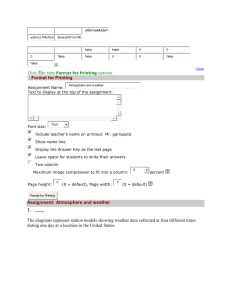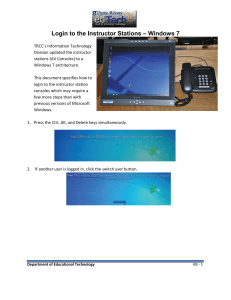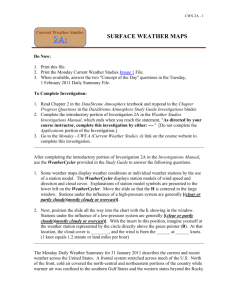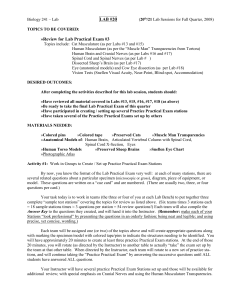Air Pressure & Wind Activity: Weather Studies Investigation
advertisement
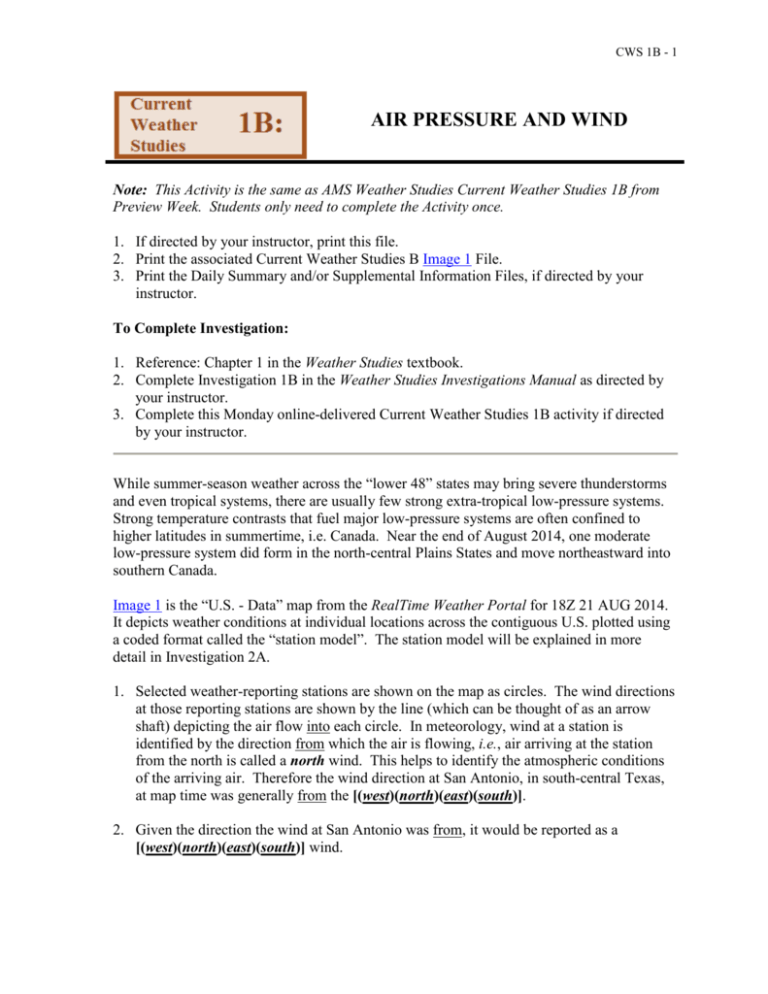
CWS 1B - 1 AIR PRESSURE AND WIND Note: This Activity is the same as AMS Weather Studies Current Weather Studies 1B from Preview Week. Students only need to complete the Activity once. 1. If directed by your instructor, print this file. 2. Print the associated Current Weather Studies B Image 1 File. 3. Print the Daily Summary and/or Supplemental Information Files, if directed by your instructor. To Complete Investigation: 1. Reference: Chapter 1 in the Weather Studies textbook. 2. Complete Investigation 1B in the Weather Studies Investigations Manual as directed by your instructor. 3. Complete this Monday online-delivered Current Weather Studies 1B activity if directed by your instructor. While summer-season weather across the “lower 48” states may bring severe thunderstorms and even tropical systems, there are usually few strong extra-tropical low-pressure systems. Strong temperature contrasts that fuel major low-pressure systems are often confined to higher latitudes in summertime, i.e. Canada. Near the end of August 2014, one moderate low-pressure system did form in the north-central Plains States and move northeastward into southern Canada. Image 1 is the “U.S. - Data” map from the RealTime Weather Portal for 18Z 21 AUG 2014. It depicts weather conditions at individual locations across the contiguous U.S. plotted using a coded format called the “station model”. The station model will be explained in more detail in Investigation 2A. 1. Selected weather-reporting stations are shown on the map as circles. The wind directions at those reporting stations are shown by the line (which can be thought of as an arrow shaft) depicting the air flow into each circle. In meteorology, wind at a station is identified by the direction from which the air is flowing, i.e., air arriving at the station from the north is called a north wind. This helps to identify the atmospheric conditions of the arriving air. Therefore the wind direction at San Antonio, in south-central Texas, at map time was generally from the [(west)(north)(east)(south)]. 2. Given the direction the wind at San Antonio was from, it would be reported as a [(west)(north)(east)(south)] wind. CWS 1B - 2 The wind speed is reported by a combination of long (10 knots) and short (5 knots) “feathers” attached to the direction shaft. At map time, San Antonio had a 15-knot wind (one long and one short feather). [A double circle without a direction shaft signifies calm conditions, such as Grand Junction, in western Colorado, whereas a shaft without feathers would denote 1-2 knots. One knot (1 nautical mile per hour) is about 1.2 land (statute) miles per hour.] 3. A bold red “L” has already been marked on the map along the eastern portion of the border between North and South Dakota to denote the general center of low pressure in that area. Compare the hand-twist model of a Low to the wind directions at stations surrounding the low-pressure center. Wind directions at these stations suggest that, as seen from above, the air spiraled generally [(clockwise)(counterclockwise)] around this Northern Hemisphere low-pressure center. 4. The winds at stations near the low-pressure center indicated that the air also was directed generally [(inward toward)(outward from)] the low-pressure center. 5. This wind flow pattern about the Low is therefore [(consistent with)(contrary to)] the hand-twist model of a Low. 6. A bold blue “H” has been marked on the map in central Alabama to denote the general center of high pressure in that area. Compare the hand-twist model of a High to the wind directions at stations in the several-state area surrounding the high-pressure center. Wind directions at these stations suggest that, as seen from above, the air spiraled generally [(clockwise)(counterclockwise)] around this Northern Hemisphere high-pressure center. 7. The air also spiraled generally [(inward toward)(outward from)] the high-pressure center. 8. This wind flow pattern about the High is [(consistent with)(contrary to)] the hand-twist model of a High. 9. The surface weather map from the Monday Current Weather Studies A (Image 2) on the course website was for the same time as this activity’s Image 1. The Monday Image 2 weather map shows the pressure analysis using isobars. The isobar pattern on the Monday Image 2 map [(did)(did not)] generally depict the positions of the L and the H found on this CWS Image 1 map. (Also, if you look at the isobar pattern you drew on Monday’s Image 1 map; it should also reveal these same pressure centers.) When the current weather map available on the RealTime Weather Portal shows centers of Lows or Highs near your location, you might consider your local wind direction (as reported on weathercasts or shown by a nearby flag flapping in the wind, for example) with map circulations and the hand-twist model of weather systems. The typical designation of the Ls and Hs as centers of stormy and fair weather systems, respectively, can be compared to satellite views showing clouds across the U.S. Check to see if the region immediately around a Low is generally cloudy or the broad area centered on a High as mostly clear. CWS 1B - 3 A website that dynamically displays the forecast wind flow at the time shown in both direction and speed at locations across the U.S. can be found at: http://hint.fm/wind/. Moving your cursor across the map will give the wind speeds at specific locations. You might compare the wind flow patterns seen at this site to those of the latest surface weather map’s positioning of Highs and Lows. Another interactive map showing winds across the globe is: http://earth.nullschool.net/. Further details for deciphering station data can be found in your User’s Guide (linked from the RealTime Weather Portal). The reporting surface weather stations plotted on course maps can be identified from the “Available Surface Stations” link on the course website’s Surface data section and identities given in the “User’s Guide”. Also a map of National Weather Service offices can be found at: http://www.wrh.noaa.gov/wrh/forecastoffice_tab.php. One tool for wind speed conversions between miles per hour and knots (as well as other quantities) and their formulae can be found at: http://www.srh.noaa.gov/epz/?n=wxcalc. If directed by your instructor, place the answers to Investigation 1B and Current Weather Studies 1B on the B Answer Form linked from the RealTime Weather Portal. Return to AMS Weather Studies RealTime Weather Portal ©Copyright 2014, American Meteorological Society


